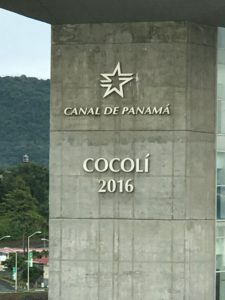Panama Canal Cruise Recap: Day Nine
This is what we were waiting for – our day to transit the Panama Canal.
Our day began around 5am as we left our position in the Balboa Anchorage area and started towards the first set of locks. As the sun started to rise, we were treated to both a nighttime and sunrise view of downtown Panama City. The skyline is much larger than I expected and quite impressive. We also passed under the Bridge of the Americas before heading towards our first set of locks. We also got a glimpse of the USS Columbus, a Los Angeles class US Navy submarine that was behind us headed for the old locks.
We arrived at the Cocoli locks a bit behind schedule but we had been warned that transits are often delayed. There was a ship ahead of us in the “line” and before we could enter the first lock, the preceeding ship had to clear the lock and it had to be “reset” to a level that matched the level of the Pacific. When you enter the Panama Canal at either end, you are climbing the stairs, so to speak. There are three locks that take your vessel up about 80 feet above sea level and into the canal. The old locks (Miraflores & Pedro Miguel Locks on the Pacific side and Gatun Locks on the Atlantic side) have two sets so there can be two-way traffic at all times. The new locks, which our ship must use due to our length, only have one set of locks at each ocean so a vessel must pass all the way through before a ship traveling in the opposite direction can begin its journey. This makes the new locks significantly slower than the old ones.
Once it was finally time for us to enter, we moved very slowly under the watchful eye of several tugboats. One boat was tied to our bow while the others simply sat to either side making sure we didn’t drift into the walls. The old locks use locomotives to guide the ships through but the new locks do not have this feature. So instead, we entered each lock and then cast off lines to be tied to the shoreline. Those lines were tightened or loosened as needed to help keep us in the center of the locks, while the tug at our bow helped keep the front of the ship straight. The Disney Wonder also used its engines and side thrusters to keep us even within the locks. We are about 106 feet wide and the locks are about 160, so we had almost 30 feet of clearance on each side.
When you enter each lock, the door ahead of you is closed and once inside, the door behind you closes. These doors float into place using very little electricity and are hollow as well to cut down their weight. But they do a great job of sealing the locks. Once inside, the raising or lowering begins. In the Cocoli locks (the new locks on the Pacific Side) we entered and then the locks were flooded to raise the ship to the level of the next lock. Once we reached the same level as the next lock, the forward doors were opened, we sailed into the next lock, and then repeated the process. Each basin took about 15 minutes to fill and the entire three lock process took about two hours.
Once we’d passed the three Cocoli locks, we were over 80 feet above sea level and entered the canal. The canal is comprised of a few waterways including the Chagres River and the artificial Gatun Lake. The lake took over seven years to fill with water and is quite impressive. Once you leave the Cocoli locks, you first pass through the Culebra Cut. This is a roughly eight mile area that is cut out of the continental divide. The channel was literally cut from the mountains and on each shoreline you can see where the rock and dirt was cut away to create the waterway. Inside the cut we also passed under a second bridge – the Millennium Bridge.
Once out of the cut, we entered Gatun Lake. We were scheduled to spend about three hours in the lake itself. We could have made the journey faster but we had a specific time to arrive at the Agua Clara locks and I suspect we paced ourselves according to that schedule. We passed many vessels but no other cruise ships. One of the more interesting ships we saw was carrying the propeller blades for those large windmill farms.
As we approached the last three locks, we actually stopped for over an hour to wait our turn. We were informed by the Panama Canal authorities that our slot for the locks would be delayed until around 2:40pm. In front of us was a huge container ship and it was fun to watch it go through the locks before us – a kind of preview of things to come. Finally around 2:50pm we started our engines again and headed for the first lock.
Since we need to get back to sea level to enter the Atlantic/Caribbean, the process from the first three locks is reversed. We still enter and then the door behind us closes. But instead of flooding the lock, the water is drained. The new locks have three retention chambers per lock and this allows them to re-use most of the water, saving about 60% of the water used during each cycle. This is much more efficient than the old locks and it was very cool to watch the water flood in or out as the retention pools filled or drained. The engineering required to do this is incredibly impressive.
The final three locks took about another two hours and we were clear of the canal right before 5pm. Immediately after the last locks we passed a third bridge, known (for now at least) as the Atlantic Bridge. It’s currently under construction and expected to open next year.
The transit was everything I expected and so much more. If you’re an avid cruiser (or even if you’re not) this should be high on your list of things to experience. I also have to give a huge “well done” to Disney Cruise Line for going the extra mile in so many ways.
First, since it’s the rainy season, we were all given complimentary Disney Parks ponchos to keep us dry. The ship also had special Panama Canal t-shirts available on deck as we entered the first lock. Since we couldn’t go to the restaurants for breakfast without missing the canal, the crew brought coffee, tea and pastries on deck and walked around making sure everyone had something to eat. They also had a live narration available both on the ship’s public address system and also via the stateroom televisions. I personally watched the first lock from the top deck and then moved to my balcony to enjoy the rest of the transit.
Tomorrow we arrive in Cartagena, Colombia and have a private car for our group to take us to see the sights. But before I wrap up for the day, I wanted to leave you with a few Panama Canal fun facts:
• The official opening of the Panama Canal was on August 15, 1914
• Between 12,000 and 15,000 ships cross the canal each year
• Each ship must pay a toll. Ours was around $470,000. Tolls are based on a ship’s size and volume, although cruise ships are charged by the passenger
• The lowest toll ever paid was $0.36 by Richard Halliburton, who swam the canal
• The Panama Canal Expansion (new locks) began in 2007 and was completed in June 2016
• The Disney Wonder was the first cruise ship to use the new locks when she transited from the Atlantic to the Pacific earlier this year
• When you travel between the seas, you are actually going North/South, not East West. The Atlantic is to the North and the Pacific is to the South
• The estimated cost of building the new locks was $5.25 billion
• The allowed length of ships increased from 965 feet to 1200 feet. The allowable width increased from 106 to 160 feet
• The new lock chambers are 180 feet wide, 1400 feet long and 60 feet deep
• The new lock chambers hold 65% more water than the original locks and use 7% less water per transit
















